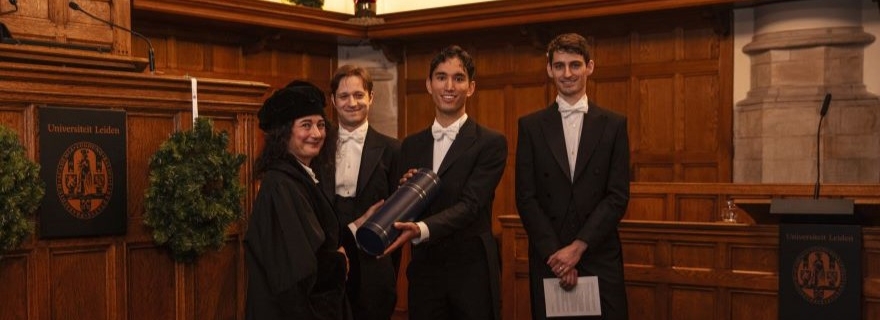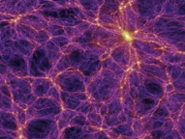
Not everything that comes close to a black hole is swallowed by it. Black holes can also hurl material away, and that chance turns out to be considerably bigger than previously thought. Martijn Oei's accidental discovery and his subsequent research on it earned him a cum laude promotion on 12 December.

Originally, astronomer Martijn Oei aimed to detect the cosmic web. To finally reveal the structure of the universe that resembles the neural networks in our brains. 'With the European LOFAR telescope to which my supervisors Huub Röttgering and Reinout van Weeren have dedicated their careers, this might be achievable.'
The disappointment lasted less than an hour
Once the telescope's images were processed to have high sensitivity to weaker radiation, the search could begin. Oei: 'I was curious of course, and looked immediately. It was risky research; we knew there was a chance the web would not be visible.' And indeed: there was little to be seen that resembled the cosmic web. But that disappointment lasted less than an hour. 'I saw a massive burst from a galaxy. Two clouds on either side of it, the distance from one to the other was a hundred times bigger than the galaxy itself.'

Het grootste reuzenradiostelsel ooit, en nog veel meer
The largest giant galaxy ever, and much more
What Oei saw was a kind of volcanic eruption from a black hole, often found at the centre of a galaxy. In such an eruption, two jets of material hurl out of the galaxy at nearly the speed of light. The resulting plumes are called giant radio galaxies. Oei had found the largest one ever. It was called Alcyoneus and received a lot of media attention.
The discoveries did not stop there. Oei shifted his attention from the cosmic web to giant radio galaxies and discovered that the phenomenon is much less rare than thought. 'About a thousand giant radio galaxies were known from the literature, accumulated over decades. I first saw this one, which was immediately the largest, but then closer inspection of the images revealed another two thousand giant radio galaxies.' Next, Oei set up an automatic search, together with fellow PhD student Rafaël Mostert 'With machine learning, Rafaël and I were able to train a programme that was especially good at finding smaller ones that we cannot see. That's how we found another eight thousand radio galaxies.'
Not even an extremely heavy hole
So in total, Oei found ten thousand new giant radio galaxies. The largest, most violent volcanic eruption turned out not to even come from an extreme galaxy. 'More important than my other discoveries, perhaps, is that the black hole from which those largest plumes came was not even extremely heavy. Just like the galaxy in which that black hole is located.' The coming years may reveal how this is possible, with the sharper images of black holes that telescopes like LOFAR and the Event Horizon Telescope will capture.

Promotor Huub Röttgering explains that Oei's discoveries are of great significance. 'It turns out that galaxies can have a much greater influence on their environment than we thought.'
Oei's second promotor and daily supervisor Reinout van Weeren explains that it is certainly not just his accidental discoveries that earned Oei the cum laude designation. 'The thesis contains an exceptional combination of theory, advanced statistical modelling, pioneering observations and instrumental techniques. It is rare that all these aspects are expressed to this extent in a dissertation.'
Original ideas and a good writer
In working together, Van Weeren noticed that Oei works differently from most other PhD candidates. 'Most of them start with the literature, when beginning their research, and then think further. Martijn doesn't. He starts with himself and then comes up with original ideas. For example, he wondered why giant radio galaxies are so rare and why there are more small ones than large ones. He reasoned from the basics and came up with a good explanation. Actually better than those of others who had speculated about it before.' Van Weeren also admires the way Oei talks and writes about his work. 'The Dutch summary in his thesis, for example, is written very beautifully and easily readable.'

Corona period was tough
It seems like almost everything went smoothly in Oei's PhD research. The work went very well, but during the corona period he had a tough time. 'My work could continue, but I felt very isolated when working from home. I love working together and found it very annoying that you had to plan every little conversation. You couldn't just bump into each other at the coffee machine to share something.'
In October, Oei started a new job as a postdoctoral researcher at the California Institute of Technology (Caltech) in Los Angeles. 'There I continue to work on giant radio galaxies, and on the search for the cosmic web. But I keep an open mind, to also learn about the topics Caltech specialises in.'
Martijn Oei received his PhD with honours on 12 December for the thesis Giant galactic outflows and shocks in the Cosmic Web.
Text: Rianne Lindhout






